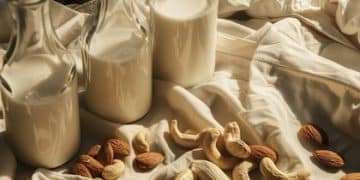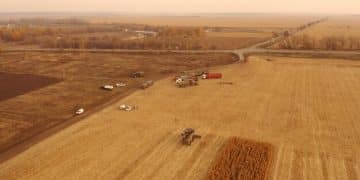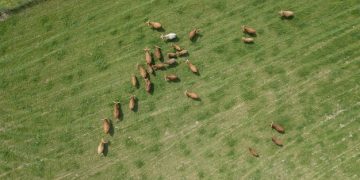US Livestock Market: Analyzing Rising Feed Costs & Profit Margins
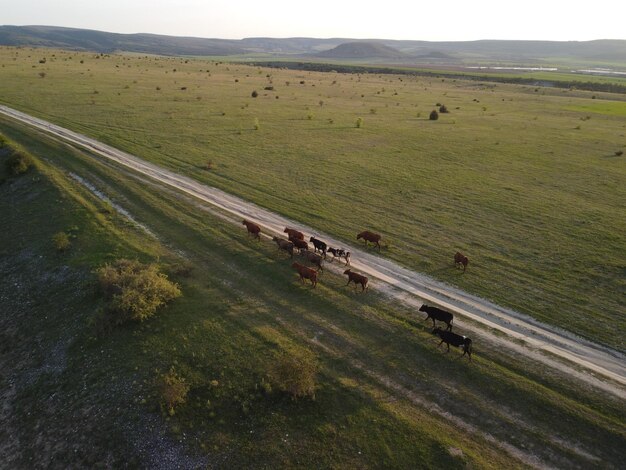
The US livestock market is currently facing significant challenges due to rising feed costs, which are impacting the profit margins of farmers and ranchers, necessitating strategic adjustments to maintain viability.
The **US livestock market** is a dynamic and essential part of the American agricultural economy, providing meat, dairy, and other products to consumers across the nation and around the globe. However, it’s a sector constantly navigating fluctuating economic conditions, and currently, one of the most pressing challenges is the rising cost of feed.
Understanding the US Livestock Market Dynamics
The US livestock market encompasses a wide range of animals, including cattle, hogs, poultry, and sheep. Each sector faces unique challenges and opportunities, but rising feed costs have emerged as a common concern across the board. Understanding the market dynamics is crucial for stakeholders to make informed decisions and adapt to the changing landscape.
Key Components of the Livestock Market
The livestock market’s functionality hinges on several key components, eachPlaying a critical role in the overall supply chain. These components include feed production, livestock breeding and raising, processing and distribution, and consumer demand.
- Feed Production: The foundation of the livestock industry, involving the cultivation of grains, soybeans, and other feedstuffs.
- Livestock Breeding and Raising: The core of the industry, where farmers and ranchers breed, raise, and care for animals until they are ready for market.
- Processing and Distribution: This stage involves slaughtering, processing, packaging, and distributing meat and other animal products to retailers and consumers.
- Consumer Demand: Ultimately drives the market, influencing production levels and pricing based on preferences for different types of meat and animal products.
These components are interconnected, and fluctuations in one area can ripple through the entire market. For example, a drought impacting feed production can lead to higher feed costs, which in turn can reduce the profitability of livestock farmers.
In conclusion, understanding the interconnectedness of feed production, livestock raising, processing, and consumer demand is essential for navigating the complexities of the US livestock market. Strategies that address rising feed costs while maintaining quality and meeting consumer needs are crucial for the industry’s long-term success.
The Escalating Costs of Feed: A Major Concern
Feed is the single largest expense for most livestock operations, representing a substantial portion of their overall production costs. Therefore, any increase in feed prices can significantly impact profitability, forcing producers to make tough decisions about herd sizes, feeding strategies, and marketing approaches.
Factors Contributing to Rising Feed Costs
Several factors have contributed to the recent surge in feed costs. These include weather-related events, global demand, trade policies, and biofuel mandates.
- Weather-Related Events: Droughts, floods, and other extreme weather events can disrupt crop production, reducing yields and increasing prices.
- Global Demand: Increasing demand for meat and animal products in developing countries is putting upward pressure on feed prices.
- Trade Policies: Trade disputes and tariffs can disrupt the flow of feedstuffs, impacting prices and availability.
- Biofuel Mandates: Government mandates requiring the use of biofuels can divert corn and other feed grains away from livestock production, driving up prices.
These factors often interact, creating a complex and volatile environment for livestock producers. Understanding these drivers is crucial for mitigating the impact of rising feed costs on profit margins.
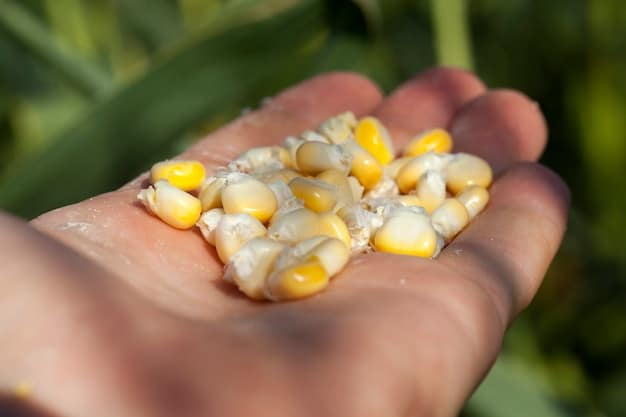
In conclusion, the escalating costs of feed pose a significant threat to the US livestock market, driven by weather events, global demand, trade policies, and biofuel mandates. Mitigating these impacts requires a combination of strategic feed management, risk mitigation strategies, and supportive policies.
Impact on Profit Margins for Livestock Producers
The impact of rising feed costs on profit margins varies depending on the type of livestock operation, the size of the operation, and the producer’s ability to adapt. However, in general, higher feed costs translate to lower profits.
Specific Effects on Different Livestock Sectors
Each livestock sector experiences the impact of rising feed costs differently, depending on their feeding practices and market dynamics.
Cattle: Cattle operations often rely on pasture grazing, but supplemental feeding is usually necessary, especially during winter months or periods of drought. Higher feed costs can reduce the number of cattle ranchers can afford to maintain, leading to smaller herds.
Hogs: Hog production is highly dependent on grain-based feeds. Rising corn and soybean meal prices can dramatically reduce profit margins for hog farmers, forcing them to become more efficient in their feeding strategies.
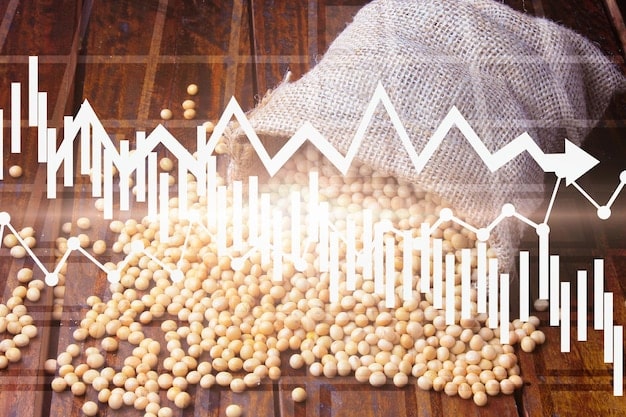
The impact on profit margins extends beyond individual producers, affecting the entire supply chain and ultimately influencing consumer prices.
In conclusion, the rise in feed costs significantly diminishes profit margins for US livestock producers, impacting cattle and hog farmers differently and influencing the whole supply chain. Effective farm management and policy changes are essential to mitigate these effects.
Strategies for Mitigating Rising Feed Costs
Given the significant impact of rising feed costs, livestock producers are exploring various strategies to mitigate these costs and protect their profit margins. These strategies range from optimizing feeding practices to diversifying feed sources and implementing risk management tools.
Optimizing Feeding Practices and Efficiency
One of the most effective ways to reduce feed costs is to improve feeding efficiency. This involves carefully managing feed rations, minimizing waste, and ensuring animals receive the nutrients they need to grow and thrive.
- Precision Feeding: Using technology to deliver the right amount of feed to each animal based on its individual needs.
- Feed Additives: Incorporating additives like enzymes and probiotics to improve feed digestibility and nutrient absorption.
- Pasture Management: Optimizing grazing practices to maximize forage utilization and reduce the need for supplemental feeding.
By implementing these strategies, producers can reduce their overall feed consumption and lower their costs without compromising animal health or productivity.
In conclusion, optimizing feeding practices and enhancing efficiency are crucial strategies for US livestock producers to mitigate the impact of rising feed costs. Precision feeding, advanced feed additives, and smart pasture management each contribute to more sustainable and cost-effective farming.
Diversifying Feed Sources and Ingredients
Relying solely on traditional feed grains can leave producers vulnerable to price fluctuations and supply disruptions. Diversifying feed sources can help to reduce this risk and provide more cost-effective alternatives.
Exploring Alternative Feedstuffs
Many alternative feedstuffs can be incorporated into livestock diets, including crop residues, byproducts from food processing, and unconventional forages.
Crop Residues: Corn stalks, wheat straw, and other crop residues can be used as a roughage source for cattle, especially during periods when pasture is limited.
Byproducts: Ingredients like distillers grains from ethanol production, brewers grains from beer making, and cottonseed meal from cotton production can provide valuable nutrients at a lower cost than traditional feed grains.
In summary, broadening the range of feed sources through crop residues and byproducts offers significant potential for lowering feed costs. Innovative farming techniques and strategic resource use can enable livestock producers to maintain profitability amid market volatility.
Risk Management and Financial Strategies
In addition to operational strategies, livestock producers can utilize various risk management and financial tools to protect their profit margins from rising feed costs. These include hedging, insurance, and government programs.
Utilizing Hedging and Insurance Tools
Hedging involves using futures contracts to lock in a price for feed grains, protecting producers from unexpected price increases.
Livestock Risk Protection (LRP): Government-subsidized insurance programs that protect producers from declines in livestock prices.
Pasture, Rangeland, and Forage (PRF) Insurance: Helps producers manage the risk of reduced forage production due to drought.
Proactive financial planning and risk management are essential for livestock operations to remain resilient in the face of market volatility and environmental challenges.
| Key Area | Brief Description |
|---|---|
| 🌱 Rising Feed Costs | Impact profit margins significantly. |
| 🐄 Strategic Feeding | Optimize rations & reduce waste. |
| 🌾 Alternative Feeds | Use crop residues and byproducts. |
| 🛡️ Risk Management | Implement hedging and insurance tools. |
Frequently Asked Questions
▼
Rising feed costs are due to factors like weather events impacting crop production, global demand for animal products, trade policies disrupting supply, and biofuel mandates diverting feed grains to fuel production.
▼
Higher feed costs reduce profit margins, forcing farmers to decrease herd sizes, optimize feeding strategies, and explore alternative feed sources to remain economically viable.
▼
Farmers can use crop residues like corn stalks, byproducts from food processing like distillers grains, and unconventional forages to diversify and lower feed costs.
▼
Risk management tools include hedging with futures contracts, Livestock Risk Protection (LRP) insurance, and Pasture, Rangeland, and Forage (PRF) insurance to protect against price and production risks.
▼
Feeding practices can be optimized using precision feeding technologies, incorporating feed additives to improve digestion, and implementing pasture management to maximize forage utilization and reduce waste.
Conclusion
In conclusion, the US livestock market faces significant challenges due to rising feed costs impacting profit margins. Strategic adjustments like optimizing feeding practices, diversifying feed sources, and employing risk management tools are essential for farmers to maintain viability and ensure the long-term sustainability of the industry.
